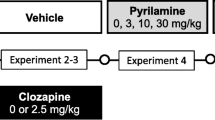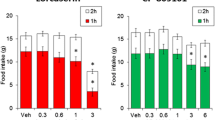Abstract
The effects of six 5-HT anorectic agents,d-fenfluramine (5-HT releaser and reuptake inhibitor), fluoxetine (5-HT reuptake inhibitor), mCPP (5-HT1B/5-HT1C receptor agonist), RU24969 (5-HT1A/5-HT1B receptor agonist), MK212 (5-HT1C receptor agonist) and DOI (5-HT2/5-HT1C receptor agonist), and two non-5-HT anorectic agents, salbutamol (beta2-adrenergic agonist) andd-amphetamine (catecholaminergic agonist), were examined in an experimental procedure designed to disclose selective effects on carbohydrate consumption. In this procedure, a revised version of what we have termed “The Classic Sclafani Paradigm”, animals are presented with powdered Polycose as an optional carbohydrate supplement to hydrated chow (nutritionally complete diet). All drugs produced significant reductions in total (hydrated chow plus powdered Polycose) intake. However, only the 5-HT drugs DOI and fluoxetine exerted significantly stronger anorectic effects on intake of powdered Polycose than on intake of hydrated chow.d-Fenfluramine also showed a tendency to selectively suppress Polycose intake but this effect marginally failed to reach significance. These results suggest that when experimental conditions are favourable, what appears to be selective carbohydrate (Polycose) suppression can be demonstrated with certain 5-HT drugs. They also suggest that a selective effect on carbohydrate intake is not the most prominent feeding response to 5-HT drugs.
Similar content being viewed by others
References
Bendotti C, Samanin R (1987) The role of putative 5-HT1A and 5-HT1B receptors in the control of feeding in rats. Life Sci 41:635–642
Blundell JE (1983) Problems and processes underlying the control of food selection and nutrient intake. In: Wurtman RJ, Wurtman JJ (eds) “Nutrition and the brain”, vol. 6. Raven, New York, pp 163–221
Blundell JE, Hill AJ (1987) Nutrition, Serotonin and Appetite: Case study in the evolution of a scientific idea. Appetite 8:183–194
Blundell JE, Hill AJ (1989) Do serotoninergic drugs decrease energy intake by reducing fat or carbohydrate intake? Effects ofd-fenfluramine with supplemented weight-reducing diets. Pharmacol Biochem Behav 31:773–778
Borsini F, Bendotti C, Thurlby P, Samanin R (1982) Evidence that systemically administered salbutamol reduces food intake in rats by acting on central beta-adrenergic sites. Life Sci 30:905–911
Carlsson A (1970) Amphetamine and brain catecholamines. In: Costa E, Garattini S (eds) Amphetamines and related compounds. Raven, New York, pp 289–300
Clineschmidt BV, Hanson HM, Pflueger AB, McGuffin JC (1977) Anorexigenic and ancillary action of MK212 (6-chloro-2-[1-piperazinyl]-pyrazine). Psychopharmacology 55:27–33
Conn PJ, Sanders-Bush E (1987) Relative efficacies of piperazines at the phosphoinositide hydrolysis-linked serotoninergic (5-HT2 and 5-HT1C) receptors. J Pharmacol Exp Ther 242:552–557
Cullum VA, Farmer JB, Jack D, Levy CP (1969) Salbutamol: a new selective beta-adrenoceptive receptor stimulant. Br J Pharmacol 35:141–151
Falk JL, Tang M (1974) Salbutamol and quinterenol: dipsogenic action produced by beta-adrenergic stimulants. Pharmacol Biochem Behav 2:413–415
Fernstrom JD, Wurtman RJ (1972) Brain serotonin content: physiological regulation by plasma neutral amino acids. Science 178:414–416
Glennon RA (1986) Discriminative properties of the serotoninergic agent 1-(2,5-dimethoxy-4-iodophenyl)-2-aminopropane (DOI). Life Sci 39:825–830
Hoyer D (1989) Functional correlates of serotonin 5-HT1C recognition sites. J Recept Res 8:59–81
Hutson PH, Donohoe TP, Curzon G (1988) Infusion of 5-hydroxy-tryptamine agonists RU24969 and TFMPP into the paraventricular nucleus of the hypothalamus causes hypophagia. Psychopharmacology 97:550–552
Kennett GA, Dourish CT, Curzon G (1987) 5-HT1B agonists induce anorexia at a post-synaptic site. Eur J Pharmacol 141:429–435
King BH, Brazell C, Dourish CT, Middlemiss DN (1989) 1-(2-,5-dimethoxy-4-iodophenyl)-2-aminopropane (DOI) activation of the 5-HT2 receptor subtype increases rat plasma ACTH concentration. Soc Neurosci Abstr 15:220
Lawton CL, Blundell JE (1989) Pharmacological manipulation of 5-HT: effect on intake of diets supplemented with either sweet or bland carbohydrates. In: Bevan P, Cools AR, Archer T (eds) The behavioural pharmacology of 5-HT. Lawrence Earlbaum Associates, New Jersey Hove London, pp 295–298
Lawton CL, Blundell JE (1992) The effect ofd-fenfluramine on intake of carbohydrate supplements is influenced by the hydration of the test diets. Behav Pharmacol 3:517–523
Leibowitz SF, Weiss GF, Walsh UA, Viswanath D (1989) Medial hypothalamic serotonin: role in circadian patterns of feeding and macronutrient selection. Brain Res 503:132–140
Liebman JM, Gerber R, Pastor G, Bernard PS (1986) Evidence for a lack of involvement of 5-HT1 receptors in the regulation of food intake. Fed Proc 45:437
Luo S, Li ETS (1990) Food intake and selection pattern of rats treated with dexfenfluramine, fluoxetine and RU24969. Brain Res Bull 24:729–733
Luo S, Li ETS (1991) Effects of repeated administration of serotoninergic agonists on diet selection and body weight in rats. Pharmacol Biochem Behav 38:495–500
Macor JE, Burkhart CA, Heym JH, Ives JL, Lebel LA, Newman ME, Nielson JA, Ryan K, Schulz DW, Torgersen LK, Koe BK (1990) 3-(1,2,5,6-Tetrahydropyrid-4-yl)pyrrolo[3,2-b]pyrid-5-one: a potent and selective serotonin (5-HT1B) agonist and rotationally restricted phenolic analogue of 5-methoxy-3-(1,2,5,6,-tetrahydropyrid-4-yl)indole. J Med Chem 33:2087–2093
McArthur RA, Blundell JE (1986) Dietary self-selection and intake of protein and energy is altered by the form of the diets. Physiol Behav 38:315–319
Moses PL, Wurtman RJ (1984) The ability of certain anorexic drugs to suppress food consumption depends on the nutrient composition of the test diet. Life Sci 35:1297–1300
Orthen-Gambill N (1985) Sucrose intake unaffected by fenfluramine but suppressed by amphetamine administration. Psychopharmacology 72:130–135
Orthen-Gambill N, Kanarek RB (1982) Effects of amphetamine and fenfluramine on dietary self-selection in rats. Pharmacol Biochem Behav 16:303–309
Oomura Y, Kai Y, Shimizu N (1989) Serotonergic mechanism of food intake behaviour. Appetite 12:228–229
Peters JC, Bellissimo DB, Harper AE (1984)l-Tryptophan injection fails to alter nutrient selection by rats. Physiol Behav 32:253–259
Rowland NE, Carlton J (1986) Neurobiology of an anorectic drug: fenfluramine. Prog Neurobiol 27:13–62
Samanin R, Bendotti C, Candalares G, Garattini S (1977) Specificity of serotoninergic involvement in the decrease of food intake induced by quipazine in the rat. Life Sci 21:1259–1266
Samanin R, Mennini T, Ferraris A, Bendotti C, Borsini F, Garattini S (1979)m-Chlorophenylpiperazine: a central serotonin agonist causing powerful anorexia in rats. Naunyn Schmiedeberg's Arch Pharmacol 308:159–163
Schechter LE, Simansky KJ (1988) 1-(2,5-Dimethoxy-4-iodophenyl)-2-aminopropane (DOI) exerts an anorexic action that is blocked by 5-HT2 antagonists. Psychopharmacology 94:342–346
Sclafani A, Xenakis S (1984) Sucrose and polysaccharide induced obesity in the rat. Physiol Behav 32:169–174
Sills MA, Wolfe BA, Frazer A (1984) Determination of selective and non-selective compounds for the 5-HT1A and 5-HT1B subtypes in rat frontal cortex. J Pharmacol Exp Ther 231:480–487
Wurtman JJ, Wurtman RJ (1977) Fenfluramine and fluoxetine spare protein consumption while suppressing caloric intake by rats. Science 24:895–904
Wurtman JJ, Wurtman RJ (1979) Drugs that enhance central serotoninergic transmission diminish elective carbohydrate consumption by rats. Life Sci 24:895–904
Author information
Authors and Affiliations
Rights and permissions
About this article
Cite this article
Lawton, C.L., Blundell, J.E. 5-HT manipulation and dietary choice: variable carbohydrate (Polycose) suppression demonstrated only under specific experimental conditions. Psychopharmacology 112, 375–382 (1993). https://doi.org/10.1007/BF02244936
Received:
Revised:
Issue Date:
DOI: https://doi.org/10.1007/BF02244936




